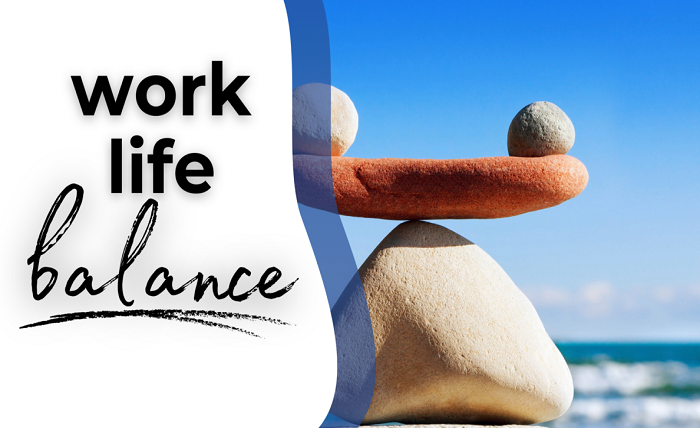Work-Life Balance and How to Achieve It With No Stress

It may seem easy to stop after a long workday, but often we can’t draw clear boundaries between the time we dedicate to work and the time we dedicate to ourselves. The concept of work-life balance allows us to combine different areas of life so we can remain productive and avoid burnout.
What Is Work-Life Balance?
Work-life balance is a concept that helps a person find equilibrium between work tasks and personal time. The principles of this approach were formulated as early as 1817 by English entrepreneur Robert Owen, who proposed dividing the day into three equal parts: 8 hours for work, 8 hours for rest, and 8 hours for sleep. The actual term work-life balance appeared in the 1970s in a book by Rosabeth Moss Kanter. At that time, the issue was especially relevant for working mothers and pregnant women trying to combine a career with family responsibilities. In the 1980s, the ideas of work-life balance became part of corporate culture: companies began implementing employee-support programs to help staff manage their time more effectively, rather than spending all their energy exclusively on work projects. With the rise of remote work, the development of technology, and new employment formats, the challenge of balancing work and personal life has become even more complex. Today, the boundaries are often blurred: work chats and notifications don’t stop in the evenings or even on weekends. Experts note that the ability to balance work tasks, family, rest, and personal growth is one of the key skills of modern life. It’s important to learn how to prioritize, plan the day, distribute tasks, and clearly define boundaries between work and personal life so that each day brings benefit and joy rather than fatigue and stress.What Is Work-Life Blend?
Work-life blend is an approach that suggests not strictly separating work and personal time, but integrating them. In this format, a person shifts between work tasks, family matters, and rest throughout the day: working on a project in the morning, spending time with children in the afternoon, and joining an online team meeting in the evening. Work-life blending is especially relevant for remote workers or entrepreneurs, as it offers a flexible schedule. What matters is not the number of hours at the desk, but overall well-being, efficiency, and a sense of harmony. The main idea of work-life blend is to adapt to different tasks and use modern technology to combine work and personal life. This approach helps you manage time better, respond quickly to new challenges, and maintain motivation even under multitasking conditions. However, it’s important to remember to set boundaries and take full breaks to prevent burnout and preserve balance. Furthermore, these breaks must be completely separate from your work. For example, you can claim a bonus through Slotsgem promotions and spin a slot for a while, or go for a walk while listening to your favorite audiobook.Who Is Work-Life Balance For?
This concept has pros and cons. Pros:- Clear separation between work time and rest
- Ability to give full attention to family, hobbies, and personal growth
- Helps set and protect boundaries
- Reduces the risk of chronic fatigue and burnout
- Supports mental and physical health
- Strict separation doesn’t account for unexpected or urgent tasks that require flexibility
- For creative or always-on roles, maintaining perfect balance is difficult
- This approach may limit the ability to respond quickly to opportunities and changes
Who Is Work-Life Blend For?
The main advantage of work-life blend is flexibility. You can choose when to complete work tasks and when to focus on family, hobbies, or rest. This approach helps use your energy more effectively, for example, tackling challenging work in the morning when you’re most alert, and saving evenings for enjoyable activities or socializing. The main disadvantage is the lack of clear boundaries between work and personal life, which can make rest less effective and cause fatigue and stress to accumulate faster. Without the ability to switch off and enforce personal rules, it’s easy to overwork and lose motivation. This approach requires self-organization skills, task management, and self-awareness. Work-life blend is suited to:- Remote workers, entrepreneurs, project managers, and employees with flexible schedules
- People who combine work and personal life throughout the day
- Those who work from home often
- People managing several projects at once who value freedom of choice
Consequences of Poor Work-Life Balance
We often think that giving all our time and energy to work will lead to the perfect result. In practice, this usually has the opposite effect. Poor balance undermines both personal life and productivity. Overwork, lack of rest, and the absence of alternative activities gradually take their toll on both body and mind.Mental Health
When boundaries blur, the brain doesn’t have time to rest. Stress, pressure, high responsibility, and deadlines can lead to anxiety, fatigue, and even chronic apathy. Motivation fades, irritability grows, and performance declines. Without intervention, this can lead to burnout or panic attacks. Some turn to alcohol or drugs to cope, risking addiction. Mental health is the foundation of productivity and harmony, and regular breaks and enjoyable activities are essential.Physical Health
Poor balance affects the body too. Lack of walks, constant snacking instead of proper meals, and insufficient sleep weaken the immune system and increase risks for weight issues, heart problems, and chronic fatigue. Stress keeps the body in “survival mode,” leading to rapid heartbeat, high blood pressure, and headaches. Physical health requires not only exercise, but also adequate rest, proper sleep, and self-care.Productivity
Working longer doesn’t always mean achieving more — that’s a myth. Rest is a reset. Stepping away from tasks allows the brain to recharge and return to them with fresh ideas. Without balance, even simple tasks take longer. Fatigue lowers creativity, efficiency, and interest in work. Work-life balance allows you to maintain productivity, complete tasks faster, and succeed more easily.Why Work-Life Balance Matters
When you find work-life balance, every area of life benefits. It provides:- More energy: Clear separation between work and rest allows full
- Better mental health: Regular downtime reduces stress and promotes a positive
- Stronger physical health: Balance creates time for exercise, walks, sleep, and self-
- Better relationships: Time with family and friends strengthens connections and offers emotional
- Growth opportunities: Free time can be used for new projects and
How Employers Disrupt Work-Life Balance
Many employers aim to increase efficiency but unintentionally harm employees’ work-life balance. This can happen through:- Expecting constant availability (24/7 calls, emails, messages)
- Imposing unpaid overtime
- Failing to define work hours clearly
- Overloading teams without providing tools or support
- Creating uncertainty in roles and processes
Tips for Achieving Balance
Balancing work and life is challenging — especially with multiple projects or a flexible schedule — but it’s possible. One useful tool is the “Wheel of Life”:- Draw a circle and divide it into areas such as work, family, personal life, health, finances, rest, spiritual growth, social activity, and self-development.
- Rate your satisfaction in each area from 1 to 10 and connect the points. A smooth shape means balance; distortions show where change is needed.
- Repeat monthly or when life changes to adjust your
- Keep a clear schedule and plan tasks in advance
- Check in on your physical and emotional state
- Block out personal time for exercise, hobbies, and relaxation
- Defend your boundaries both at work and home
- Take regular breaks, even on busy days
- Separate work and home spaces if you work remotely
- Delegate tasks when possible
- Track achievements and celebrate small wins
- Spend quality time with loved ones






